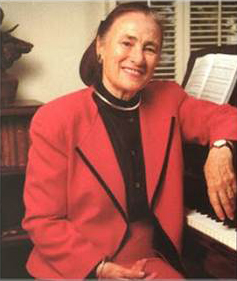 Mom died in March of 2013. As the year closes out I’m thinking of her. I never go to a classical concert without remembering how Mom saved her money when we were too poor to include meat in our diet, in order to take her children to hear the greatest classical music played by great performers. I never say “I’m sorry” to my wife Genie, without remembering who showed me how words can change reality if they’re backed up by actions. The fairy tales Mom believed in (as some folks would call her Christian faith) were her path to a life saturated with hope and light.
Mom died in March of 2013. As the year closes out I’m thinking of her. I never go to a classical concert without remembering how Mom saved her money when we were too poor to include meat in our diet, in order to take her children to hear the greatest classical music played by great performers. I never say “I’m sorry” to my wife Genie, without remembering who showed me how words can change reality if they’re backed up by actions. The fairy tales Mom believed in (as some folks would call her Christian faith) were her path to a life saturated with hope and light.
Genie and I love to visit New York City. We stay on the Upper West Side. We often walk to the Metropolitan Museum of Art. By the time we’re on the jogging path in Central Park, walking briskly around the reservoir, I feel the way I used to feel when I was eight and on my way to Italy riding on the train to our family vacation in Portofino. Our vacations were always as wonderful as I imagined they would be.
The Metropolitan Museum of Art is like some perfect childhood memory, except it’s not beyond reach. It is “about” watching wide-eyed children gathered in front of a painting with sketchbooks, making their own drawings. It is about taking my older grandchildren, Amanda and Benjamin, on pilgrimages to give them something lasting to hang on to, even though they sometimes roll their eyes and sigh when I “suggest” we’re going there—again.
I happened to be at the Met alone. Genie was off buying material at her favorite midtown fabric stores. I slipped away from a Matisse show I’d gone to see. Too many people were talking too loudly about the paintings, so I sought refuge in a place I knew would be quiet. There are very public parts of the Metropolitan Museum of Art. But there are also some corners where it feels as if you’ve brazenly walked into someone’s home.
For instance, there are hardly ever any visitors in the dim recesses of the Chinese galleries. People whisper. Everything seems intimate, almost forbidden. Sometimes visitors stumble in from the bigger, brighter parts of the museum and, as their eyes adjust to the cool dim indirect lighting, look around worriedly as if about to ask, “Are we allowed here?” Perhaps it’s the subdued light. Perhaps it’s the wood floors. But I think that the real reason for the sense that one is intruding is the intimate nature of the objects. Pens, ink pots, writing stands, tablets, finely wrought boxes—they seem as if they belong on a bedside table and are the sorts of things that children are told not to touch, ever.
I’m not “into” Chinese art the way Genie is and as my mother (who was born to missionary parents in China) was, and so I’m ignorant about it. Unless Genie is with me to explain what I’m looking at, I rarely go to the Chinese galleries. But that day several ancient jade carvings “broke through.” They seemed so impossible. I thought, there’s no way anyone could carve so intricately without modern tools.
I started really looking. Maybe it had something to do with having talked to a young Chinese woman who was my seatmate the day before on the bus from Boston to NYC. Anyway, I forgot that I only wanted to spend a few quiet moments before heading back to take another look at a particular painting in that thronged Matisse show. I stood hunched over the glass case almost forgetting to breathe and peering through my reading glasses at microscopic gnarled pine trees and rocky paths cut out of green and gray semi-opaque rock, miniature worlds that drew me in as surely as those enthralling Bible stories used to that Mom read out loud to me when I was a child.
Looking at those jade landscapes, I felt as if I had been hiking with Mom and Dad through some alpine valley and the fog had unexpectedly lifted to reveal a heart-stopping view. I was also reminded of the evenings the previous winter when I had bundled my granddaughter Lucy (then 3) up in my down parka and put on her hat and mittens and we’d go out into the garden to look at the stars.
I held Lucy clasped against my chest, and we stared up. Lucy gazed at the sliver of the universe we could see, and I stared down at my angel made of, and lit by, stardust. When she first looked upward at the vast glittering sprinkle of stars, Lucy’s breathing quickened, and then her breathing slowed along with mine as we both sank into a stunned reverie.
It was very much like the reverie I was gripped by when tumbling into those distant sixteenth-century jade inner worlds. Gazing at those jade universes, I connected powerfully with my mother’s enigmatic self as she was revealed in the sacrament of her flower arrangements. They were made of long-gone twig, moss, and leaf, but the inner liturgy they celebrated has survived in me. In the silence it struck me that Mom and I are very much alike: We each have spent most of our lives rescuing ourselves—from ourselves.
After Mom died I received hundreds of notes. The messages came from people who read a tribute I wrote about Mom the day she died. The notes included one from a hotel maid Mom talked to over forty years ago because she saw her crying in a hallway. Mom stopped to help, changed her schedule, missed a plane, talked with this stranger and then invited her to visit us. A note came from a women who had been a pregnant runaway teen that Mom that took in; from a jilted wife contemplating suicide that Mom gave new hope to and literally saved, and from a couple she’d sent money to when she learned they couldn’t pay their bills.
Mom would have said she did these things because she was following Jesus. She thought that to follow Jesus necessitated declaring her belief that every word of the Bible is literally true. I don’t. But I respect what that belief did in her life.
Mom declared this belief again and again, as if endless repetition that “the Bible is without error” would make it so. Her belief in a perfect Bible was also a paradox. Mom believed that the Bible had been written by men. She knew no men are perfect. And there were also parts of the Bible she loathed, what Mom called the “harsh parts.”
Luckily, for the people she helped my mother was gloriously inconsistent. She chose to live according to the nice bits of the Bible and ignored the rest. For instance, no matter what she said she believed the Bible said about homosexuality, Mom acted as if being born gay is just another way to be human. She provided refuge, love and compassion to many gay men and women long before the secular world woke up to the truth that gay people are normal and healthy. Dad and Mom had a lesbian couple living in our chalet for several years. One was Dad’s secretary. The other was Mom’s helper. They shared a room. Mom and Dad didn’t ever change their official doctrine about the sinfulness of gay love. Fortunately they were hypocritical and acted as if whatever their religious absolutes officially were that the higher call was to ignore what the Bible says in favor of what they hoped it means.
Mom proved by her actions that an individual can behave as if another two hundred million years or so of evolution has already happened. She’d found a Jesus-motivated short cut to a higher state of consciousness. I became an artist and a writer because of Mom’s love of art as the best evidence of the goodness of God illumined her whole life. Mom’s theological certainties motivated her to provide the most meaningful encounters with goodness and mercy many people experienced in their lifetimes. “Your mother changed my life” was something I read over and over again. “I was a ‘nobody’ and your mom stopped everything she was doing to help me.”
Merry Christmas, Mom! Thanks for living the meaning of peace on earth and goodwill to all people.
Follow Frank Schaeffer on Twitter: www.twitter.com/frank_schaeffer
Frank Schaeffer is a writer. His latest book — And God Said, “Billy!“ exploring the roots of American religious delusion, and offering another way to approach true spirituality, is on Kindle, iBook and NOOK for $3.99, and in paperback.












